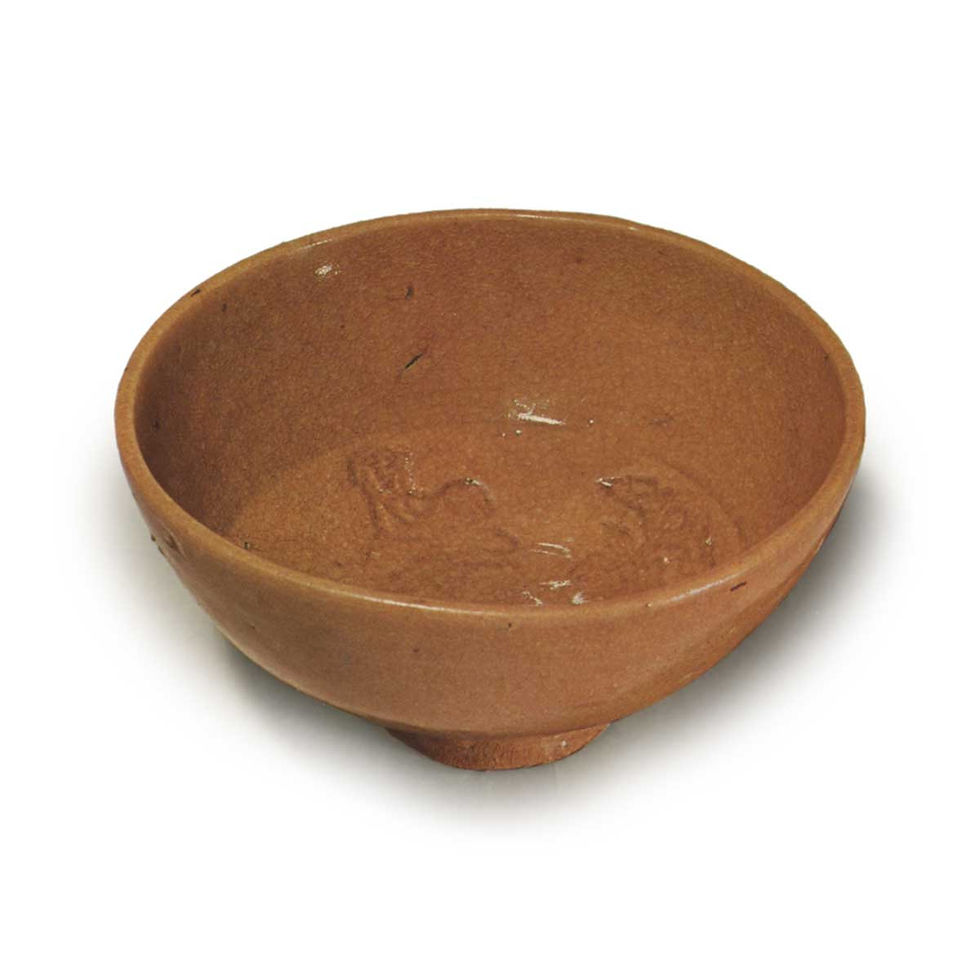茶碗筆記 vol.16 名古屋豪商十一屋、小出家:唐物青磁人形手茶碗 - Karamono Seiji Chawan, Chinese Celadon Tea Bowl with Human-Figure Decoration (Ningyōde)
- SACA

- Nov 7
- 5 min read

唐物青瓷人形手茶碗
名古屋豪商十一屋、小出家傳來
高:6.2~6.4公分
口徑:12.5~12.8公分
高臺外徑:4.7公分
同高度:1.2公分
此碗原出自名古屋豪商「十一屋」、小出家,因而以「十一屋人形手」之名著稱。胎土僅於高臺內可見,為富含鐵分之赤色土,燒結極為緻密堅實。依其胎質推測,當為浙江或福建一帶之產物。其成形由高速轆轤所作,輪廓挺拔,臺內削足處呈兜巾狀。全器施釉一面,呈泛黃橙色調,玻璃質強而光澤潤澈,釉面可見細密雙層開片。局部白色斑點(卯之斑)應為藁灰混入所致。

此釉雖顯異色,實則為以土灰為主的青瓷釉。因燒成時窯內火候或氣氛轉為氧化焰,遂呈此暖橙之色;若在還原焰中燒成,當可得與龍泉窯相同之青綠釉色。中國稱此類為「米色青瓷」,而日本茶人則以「醤手」(ひしお手,「醤」即味噌、醬料之義,指其赤色)稱之並加以珍視。相對於「馬蝗絆」或「滿月」等明麗冷峻之青磁,此種釉色溫潤柔和,更契合侘茶之幽寂意趣。
外壁素淨無飾,內壁則具人形手特有之模印裝飾:約在內壁中段刻有一水平線,其上緣沿圈施長方形連續之雷紋帶。此皆以模印成。其下方對稱押印兩組坐姿唐子與折枝唐花。古人因內壁有「人形」(即唐子)而稱此類為「人形手」。兩組唐子及折枝略異,應非不同模具所作,而是壓印力道差異所致。四印所圍之內底形成直徑約三公分之茶溜,為全器增添別趣。
觀其照片可見胎膚遍布大小氣孔與瑕疵,臺足「畳付」處尚有黏著痕,稱不上上乘之作。然而其勻整的器形與溫雅的釉色,正是昔日侘茶人所賞之風致。此種審美取向,後來發展為枇杷色粗肌的井戶茶碗趣味。
傳承脈絡為:名古屋十一屋小出家 → 昭和七年歸於大原三樂庵 → 現藏家。
為人形手茶碗中公認第一之作。
(佐藤雅彦)

Chinese Celadon Tea Bowl with Human-Figure Decoration (Ningyōde)Formerly in the Possession of the Nagoya Merchant House “Jūichi-ya,” the Koide Family
Height: 6.2–6.4 cmMouth diameter: 12.5–12.8 cmFootring diameter: 4.7 cmFoot height: 1.2 cm
This tea bowl, transmitted through the prosperous Nagoya merchant family Jūichi-ya (Koide family), is celebrated as the “Jūichi-ya Ningyōde.” The clay body is exposed only inside the footring; it is a dense, hard-fired reddish clay rich in iron, suggesting an origin in Zhejiang or Fujian provinces.

The form, thrown on a fast wheel, is taut and well-balanced, with a helmet-shaped trimming at the inner base of the foot. The glaze, covering the entire surface, is a warm yellowish-orange with strong glassy luster and fine double crackle. White patches, known as u no hana (“hare’s fur” specks), are caused by admixture of straw ash.
Though the glaze may appear unusual, it is fundamentally a celadon glaze based on wood ash. The current color resulted from oxidation firing; had it been reduction-fired, it would have achieved the typical bluish-green hue of Longquan celadon. In China such ware is called misesé qingci (beige celadon), whereas Japanese tea connoisseurs termed it hishio-de (“soy-sauce type,” hishio referring to reddish-brown hues) and prized it for its warmth. Compared with the brilliant, somewhat aloof celadons like Bakōhan or Mangetsu, this glaze exudes a softer, warmer tone well attuned to the aesthetics of wabi-cha.
The exterior is undecorated, while the interior bears impressed ornament typical of ningyōde: around the midsection runs a horizontal line above which is a continuous band of squared leiwen (thunder-scroll) pattern. Below it are two pairs of seated karako (Chinese boys) facing each other with floral branches. The presence of these “human figures” gave rise to the term ningyōde (“human-figure type”). The two pairs vary slightly in form, likely due to differences in the impression pressure rather than distinct molds. The recessed center of about 3 cm in diameter forms a chadamari (tea pool), enhancing the bowl’s visual interest.
Although the surface shows numerous pinholes and blemishes and the foot bears adhering kiln grit—hardly qualifying it as a work of refinement—the well-proportioned form and mellow reddish glaze were precisely what early wabi-cha masters appreciated. This taste later evolved into the preference for Ido bowls with rough, loquat-colored surfaces.
Provenance: Koide family (Jūichi-ya), Nagoya → acquired by Ōhara Sanraku-an in 1932 (Shōwa 7) → present collection.
Regarded as the foremost example among ningyōde tea bowls.
(Masahiko Satō)

高さ:6.2~6.4cm口径:12.5~12.8cm高台外径:4.7cm同高さ:1.2cm
名古屋の豪商十一屋、小出家に伝来したところから、十一屋の人形手として有名な茶碗です。
土見は高台の内だけですが、鉄分の強い赤い土で、焼き締まりは堅いです。土からいって、おそらく浙江か福建あたりの産と思われます。速い轆轤(ろくろ)で仕上げたらしく、形く、高台内の削りしまいは、兜巾になっているこIXSSたゆたXrしがな。一面にかかる釉は、黄ばんだオレンジ色で、ガラス分が強いため光沢に富み、釉面には、細かな二重貫入がはいっています。所々に白い卯の斑が吹いているのは、藁灰が混じっていたからでしょう。
こう書きますと、何か特殊な釉のようにみえますが、本来は土灰を主体にした青磁釉で、ただ窯の加減か焚きぐあいかで、酸化炎焼成になったため、こういう色合いに上がったわけです。これを還元炎で焼けば、竜泉窯の青磁と同じく、美しい青緑色になったはずです。
中国では、この手を米色青磁と呼んでいますが、日本の茶人たちは「ひしお手」(ひしおは醤のつくり。赤い色をさしていったものです。)と呼んで珍重しました。「馬蝗絆」や「満月」のような、あざやかではありますが、とりすました感じの青磁の色に対し、これは暖かで柔らかく、佗び茶の趣向によくかなったからです。
茶碗の外面には、何の飾りもありませんが、内面には、人形手通有の彫飾が印されています。すなわち、内壁の半ばぐらいのところに、水平線が引かれ、その上縁に沿って、長い長方形を一単位とする、雷紋帯がめぐらされています。もちろん、これは型押しです。そしてその下縁に、座形の唐子と唐花の折れ枝が、二つずつ対向に印されています。この唐子をつかまえて、古人は人形のある茶碗、人形手と呼んだわけです。二個の唐子と折れ枝は、それぞれ形がやや違って見えますが、別の印を用いるというのも妙なことですし、たぶん、押し加減で印面が変わったのでしょう。これら四つの印紋に囲まれた内底は、径三cmほどのくぼみ、つまり茶だまりとなっており、この茶碗の景色に、いっそうの花を添えています。
写真で見るとおり、茶碗の膚には、大小さまざまの小孔や傷があり、高台の畳つきには、ひっつきまであってヽけっして上作のものとはいえませんが、その良相な作りが、ひしお色の釉調とともに、昔の佗び茶人たちに、愛でられたのでしょう。こういう好みが、やがて枇杷色の、ざんぐりした膚の、井戸茶碗などにつながってゆくのです。
伝来は、十一屋、小出家から、昭和七年、大原三楽庵の有に帰し、その後、今の所蔵家に納まりました。人形手としては、第一といわれる茶碗です。
(佐藤雅彦)
































Comments